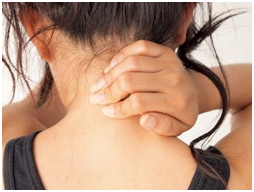 Neck Pain can occur from the top of your shoulders to the bottom of your head and is commonly experienced by most people, at some stage. It can in some cases also result in headaches.
Neck Pain can occur from the top of your shoulders to the bottom of your head and is commonly experienced by most people, at some stage. It can in some cases also result in headaches.
Common causes of neck pain include:
- sitting with poor posture watching television, reading or on your smart phone or tablet.
- sitting at a workstation that is not set up correctly
- sleeping with a pillow that is too high or too flat or sleeping on your stomach
- muscle tension
- over-doing strenuous activities such as lifting, decorating or gardening.
In most cases, the pain will settle in a few weeks. However, these Neck Pain Exercises are exteremely helpful to restore neck movement and improve pain.
If the pain doesn’t improve within 6-12 weeks, you may need to seek further advice and can refer to physiotherapy through the self referral method.
It is important to contact your medical practice if:
- Your neck pain is a result of a fall or trauma.
- You feel numbness, pins and needles or weakness that is worsening in one or both arms.
- You develop blurred vision, ringing in your ears or dizziness that doesn't go away within 48hours.
- you have problems with your balance or walking since your neck pain started.
Whiplash
If you have been assessed by a healthcare professional (Doctor, Nurse, Paramedic or Therapist) and advised you have a Whiplash injury, this leaflet includes further infromation regarding how it occurs, how it can be managed and exercises that may help.
Temporomandibular Joint (TMJ) Pain - aka Jaw pain
What is the TMJ?
The TMJ is another name for the jaw. The jaw is made up of the mandible (the lower jaw) and the temporal bone (the socket). Causes of TMJ pain include:
- Overactivity of the jaw muscles (eg. From grinding your teeth or clenching your jaw)
- Trauma as such a blow to the jaw
- Wear and tear of the joint
- Stress
What are the signs and symptoms of TMJ pain?
- pain in the jaw and facial muscles
- clicking or grinding the jaw
- headaches
- dizziness
- difficulty opening or closing the mouth properly
- pain on chewing, talking and yawning
- ringing in the ears
This leaflet includes more infromation regarding TMJ pain, management of the condition and the exercises we advise.